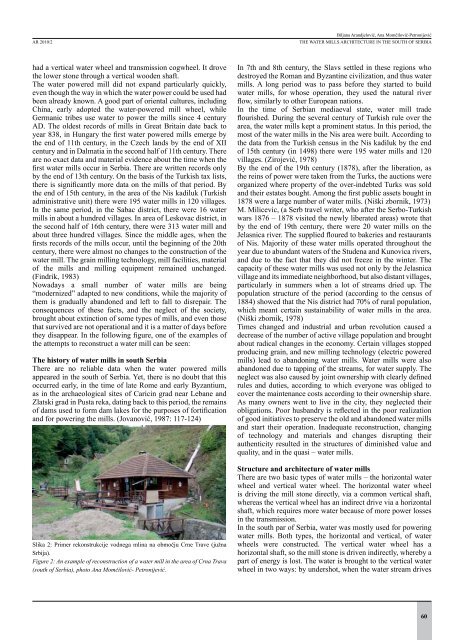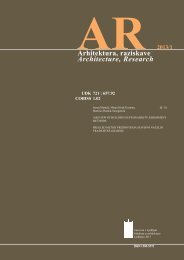AR 2010/2 - Fakulteta za arhitekturo
AR 2010/2 - Fakulteta za arhitekturo
AR 2010/2 - Fakulteta za arhitekturo
- No tags were found...
Create successful ePaper yourself
Turn your PDF publications into a flip-book with our unique Google optimized e-Paper software.
<strong>AR</strong> <strong>2010</strong>/2Biljana Arandjelović, Ana Momčilović-PetronijevićThe Water Mills Architecture in the South of Serbiahad a vertical water wheel and transmission cogwheel. It drovethe lower stone through a vertical wooden shaft.The water powered mill did not expand particularly quickly,even though the way in which the water power could be used hadbeen already known. A good part of oriental cultures, includingChina, early adopted the water-powered mill wheel, whileGermanic tribes use water to power the mills since 4 centuryAD. The oldest records of mills in Great Britain date back toyear 838, in Hungary the first water powered mills emerge bythe end of 11th century, in the Czech lands by the end of XIIcentury and in Dalmatia in the second half of 11th century. Thereare no exact data and material evidence about the time when thefirst water mills occur in Serbia. There are written records onlyby the end of 13th century. On the basis of the Turkish tax lists,there is significantly more data on the mills of that period. Bythe end of 15th century, in the area of the Nis kadiluk (Turkishadministrative unit) there were 195 water mills in 120 villages.In the same period, in the Sabac district, there were 16 watermills in about a hundred villages. In area of Leskovac district, inthe second half of 16th century, there were 313 water mill andabout three hundred villages. Since the middle ages, when thefirsts records of the mills occur, until the beginning of the 20thcentury, there were almost no changes to the construction of thewater mill. The grain milling technology, mill facilities, materialof the mills and milling equipment remained unchanged.(Findrik, 1983)Nowadays a small number of water mills are being“modernized” adapted to new conditions, while the majority ofthem is gradually abandoned and left to fall to disrepair. Theconsequences of these facts, and the neglect of the society,brought about extinction of some types of mills, and even thosethat survived are not operational and it is a matter of days beforethey disappear. In the following figure, one of the examples ofthe attempts to reconstruct a water mill can be seen:The history of water mills in south SerbiaThere are no reliable data when the water powered millsappeared in the south of Serbia. Yet, there is no doubt that thisoccurred early, in the time of late Rome and early By<strong>za</strong>ntium,as in the archaeological sites of Caricin grad near Lebane andZlatski grad in Pusta reka, dating back to this period, the remainsof dams used to form dam lakes for the purposes of fortificationand for powering the mills. (Jovanović, 1987: 117-124)Slika 2: Primer rekonstrukcije vodnega mlina na območju Crne Trave (južnaSrbija).Figure 2: An example of reconstruction of a water mill in the area of Crna Trava(south of Serbia), photo Ana Momčilović- Petronijević.In 7th and 8th century, the Slavs settled in these regions whodestroyed the Roman and By<strong>za</strong>ntine civili<strong>za</strong>tion, and thus watermills. A long period was to pass before they started to buildwater mills, for whose operation, they used the natural riverflow, similarly to other European nations.In the time of Serbian mediaeval state, water mill tradeflourished. During the several century of Turkish rule over thearea, the water mills kept a prominent status. In this period, themost of the water mills in the Nis area were built. According tothe data from the Turkish census in the Nis kadiluk by the endof 15th century (in 1498) there were 195 water mills and 120villages. (Zirojević, 1978)By the end of the 19th century (1878), after the liberation, asthe reins of power were taken from the Turks, the auctions wereorganized where property of the over-indebted Turks was soldand their estates bought. Among the first public assets bought in1878 were a large number of water mills. (Niški zbornik, 1973)M. Milicevic, (a Serb travel writer, who after the Serbo-Turkishwars 1876 – 1878 visited the newly liberated areas) wrote thatby the end of 19th century, there were 20 water mills on theJelasnica river. The supplied floured to bakeries and restaurantsof Nis. Majority of these water mills operated throughout theyear due to abundant waters of the Studena and Kunovica rivers,and due to the fact that they did not freeze in the winter. Thecapacity of these water mills was used not only by the Jelasnicavillage and its immediate neighborhood, but also distant villages,particularly in summers when a lot of streams dried up. Thepopulation structure of the period (according to the census of1884) showed that the Nis district had 70% of rural population,which meant certain sustainability of water mills in the area.(Niški zbornik, 1978)Times changed and industrial and urban revolution caused adecrease of the number of active village population and broughtabout radical changes in the economy. Certain villages stoppedproducing grain, and new milling technology (electric poweredmills) lead to abandoning water mills. Water mills were alsoabandoned due to tapping of the streams, for water supply. Theneglect was also caused by joint ownership with clearly definedrules and duties, according to which everyone was obliged tocover the maintenance costs according to their ownership share.As many owners went to live in the city, they neglected theirobligations. Poor husbandry is reflected in the poor reali<strong>za</strong>tionof good initiatives to preserve the old and abandoned water millsand start their operation. Inadequate reconstruction, changingof technology and materials and changes disrupting theirauthenticity resulted in the structures of diminished value andquality, and in the quasi – water mills.Structure and architecture of water millsThere are two basic types of water mills – the horizontal waterwheel and vertical water wheel. The horizontal water wheelis driving the mill stone directly, via a common vertical shaft,whereas the vertical wheel has an indirect drive via a horizontalshaft, which requires more water because of more power lossesin the transmission.In the south par of Serbia, water was mostly used for poweringwater mills. Both types, the horizontal and vertical, of waterwheels were constructed. The vertical water wheel has ahorizontal shaft, so the mill stone is driven indirectly, whereby apart of energy is lost. The water is brought to the vertical waterwheel in two ways: by undershot, when the water stream drives60

















